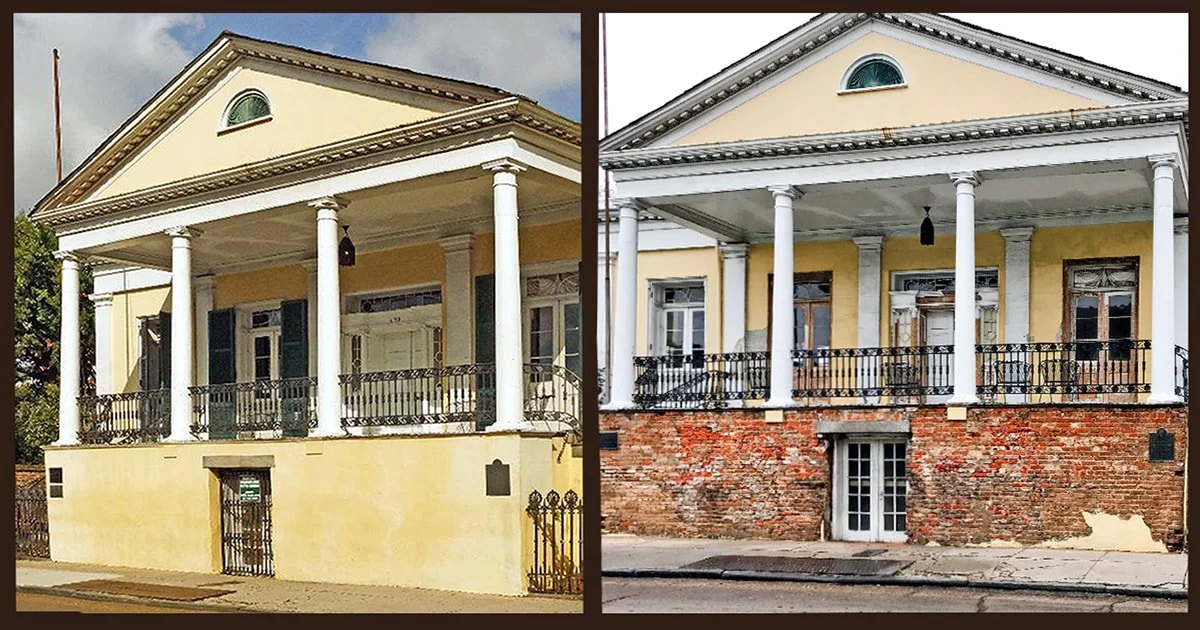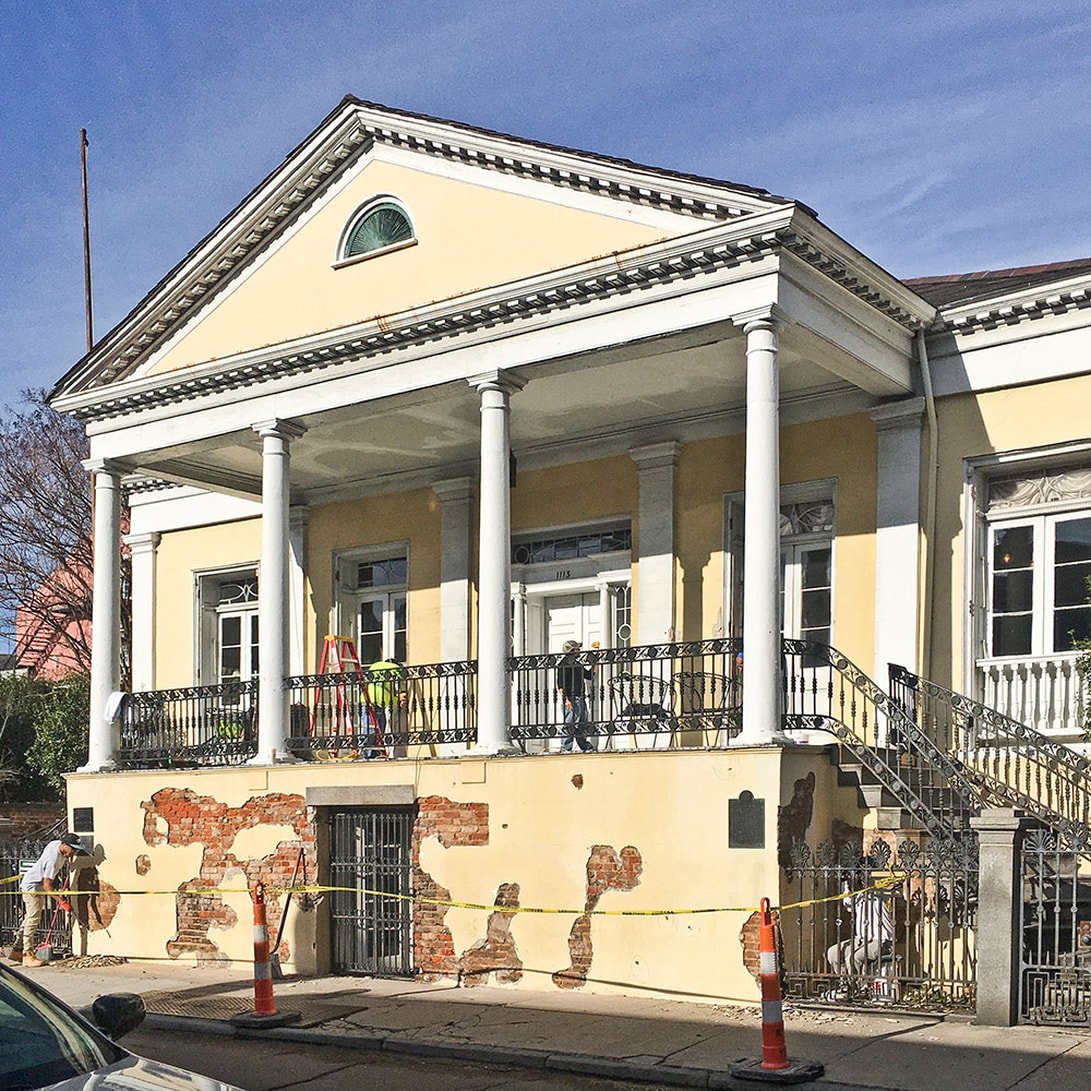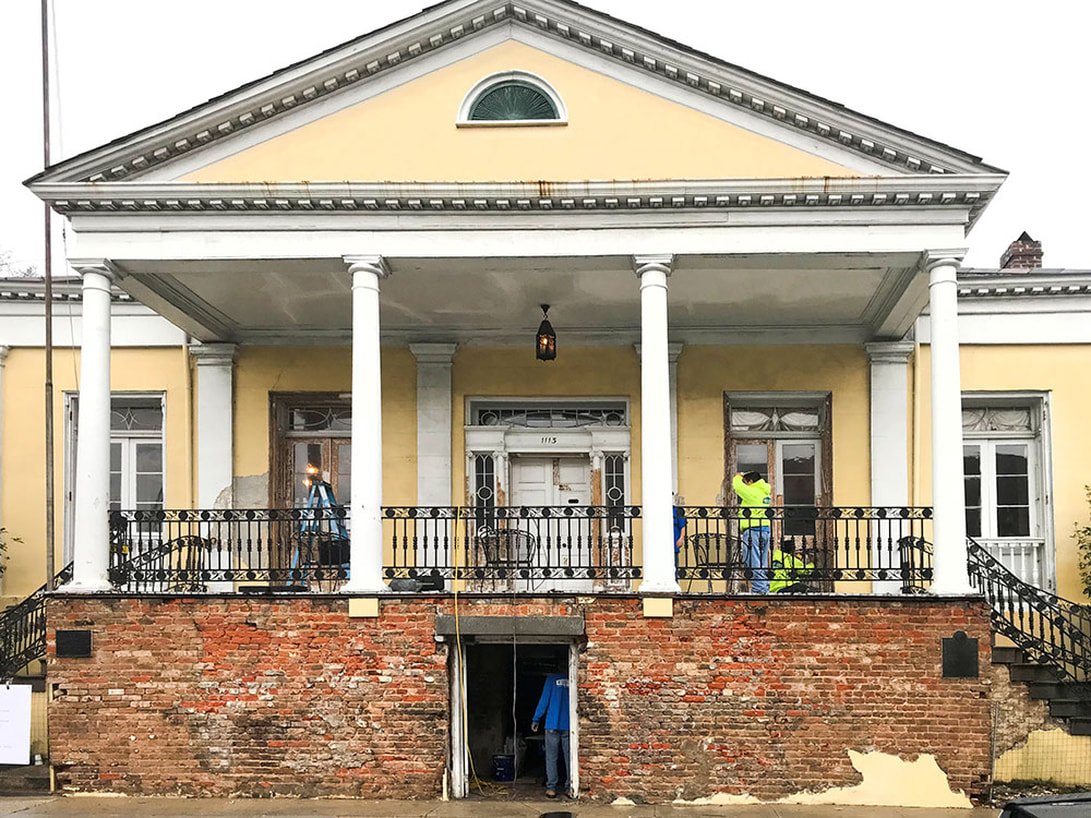The Beauregard-Keyes House restoration: the tip of the iceberg phase
January 2020For years, unseen structural issues have been addressed at the popular house museum, but now, work's progressed to the Chartres Street facade, where delightful hidden details are coming to light.
- story and photos by Ellis Anderson
Historic building restorations and icebergs have one thing in common: what’s visible to the human eye is just a tiny percentage of the whole.
So while French Quarter residents and visitors have been able to see the exterior of the Beauregard-Keyes house undergoing extreme changes during the last two weeks, they’re only witnessing the eighth phase in a long-term restoration plan that began in 2013.
A look up at the entablature that will be stripped and repaired in the process.
The house/museum, approaching its 200th birthday, was last home to author Frances Parkinson Keyes. The prolific and popular author owned it from 1945 until her death in 1970. Under her stewardship, the house, which had fallen into a state of disrepair, was restored with the guidance of noted New Orleans architect Sam Wilson.
Architect and architectural historian Robert Cangelosi - who is now president of the venerable Koch and Wilson firm - is personally overseeing the building’s current restoration.
Annie Irvin, the museum’s executive director, says the behind-the-scenes capital improvements on the property began seven years ago. The board’s first priorities were stabilizing the building and addressing safety concerns. Early phases of restoration addressed structural and drainage problems. The outdated electrical system was replaced. But these expensive and crucial projects were invisible to the eye.
“Now the public gets to see the fruits of our labors,” Irvin said.
Two Weeks Work In January
An FQJ file photo from earlier in the year
In the past two weeks, all the stucco on the ground floor has been removed. The brickwork beneath will be repointed. Impaired plaster on the second floor will be replaced. The iron work railings will be repaired and repainted.
Wood trim on the façade is being meticulously stripped of paint with heat guns. Once dozens of layers of paint were removed, fine details in the original woodwork were revealed, ornate millwork that no one knew existed. The small details had been filled in by paint over the centuries.
Looking closely, one can see where the section at the top right has been sanded. The intricate carvings must be sanded by hand.
Workmen were surprised to find intricate carvings like these beneath the layers of paint.
During the restoration, the historic house museum will also be fulfilling a commitment made eighty years ago. Because of wartime shortages in the 40s, Keyes couldn’t find age-appropriate shutters for the building when she was making improvements. The Vieux Carré Commission (VCC), which oversees architectural design in the neighborhood, granted the author permission to temporarily use newer louvered shutters instead of the paneled type that were original to the house.
The new paneled shutters were briefly installed to make sure of the fit. They've been removed to storage and will be installed permanently when the facade restoration is complete. photo courtesy BKHG
“Keyes promised the VCC that she’d replace the louvered ones with paneled ones when she could,” said Irvin. “We’re very thrilled to be fulfilling that promise.”
The historically accurate replacement shutters were milled from Spanish Cedar by Central City Millwork.
However, most noteworthy to locals will be a change of paint color.
For nearly half a century, the sunny yellow facade of the Beauregard-Keyes house has lit up the 1000 block of Chartres Street. But the bright color wasn’t original to the house and in fact, was the result of a well-intended donation.
Irvin explained that in 1972 the house was designated by Sears and Roebuck as a “Great American Home” and the company donated paint to freshen up the building.
But sunflower yellow wasn’t one of the original colors. The museum will determine the original color by having a chromochronology performed. Plugs of paint have been extracted from the building and the multiple layers will be examined under a microscope to determine the colors that have been painted on through the centuries.
Michael Shoriak and Courtney Williams of Cypress Building Conservation have been charged with the complex detective work. Shoriak is an adjunct assistant professor at Tulane University’s Preservation Studies program and will be involving students with the project.
Once the original colors have been determined, Irvin says a final decision will be made on what the new color of Beauregard-Keyes House will be. The entire exterior of the main house will be repainted.
Irwin is raising funds now for the next phases of the museum's restoration. Original plans called for completing the exterior of the main house before tackling the dependency buildings in back where Keyes had her office. But recent exploratory demolition in the smaller buildings revealed major structural issues. Irvin called the problems “a little bit of a state of emergency” and priorities have been reordered.
“We have funding for stabilization [of the dependency buildings] and are fundraising now for the restoration of that building,” said Irvin.
The elaborate iron railing will be repaired and repainted
If all goes well, the current façade restoration should completed by spring. Irvin has her fingers crossed, aware of the many unexpected problems that often materialize in any major restoration project. The clock is ticking - the historic venue hosts many weddings in the spring and fall. “We have to time our big capital improvements around booked events,” she said.
In the meantime, the popular tours are keeping to their regular schedule, although visitors wait in the lovely parterre rose garden behind the house for their tour time, rather than on the front gallery as they would normally. It's a happy trade-off as the roses are blooming, even on the rare iceberg New Orleans day.
Click here to make tax-deductible donations to the Beauregard-Keyes Historic House and Gardens.
Garden photo courtesy Beauregard-Keyes House
Your donations make stories like this one possible:
















